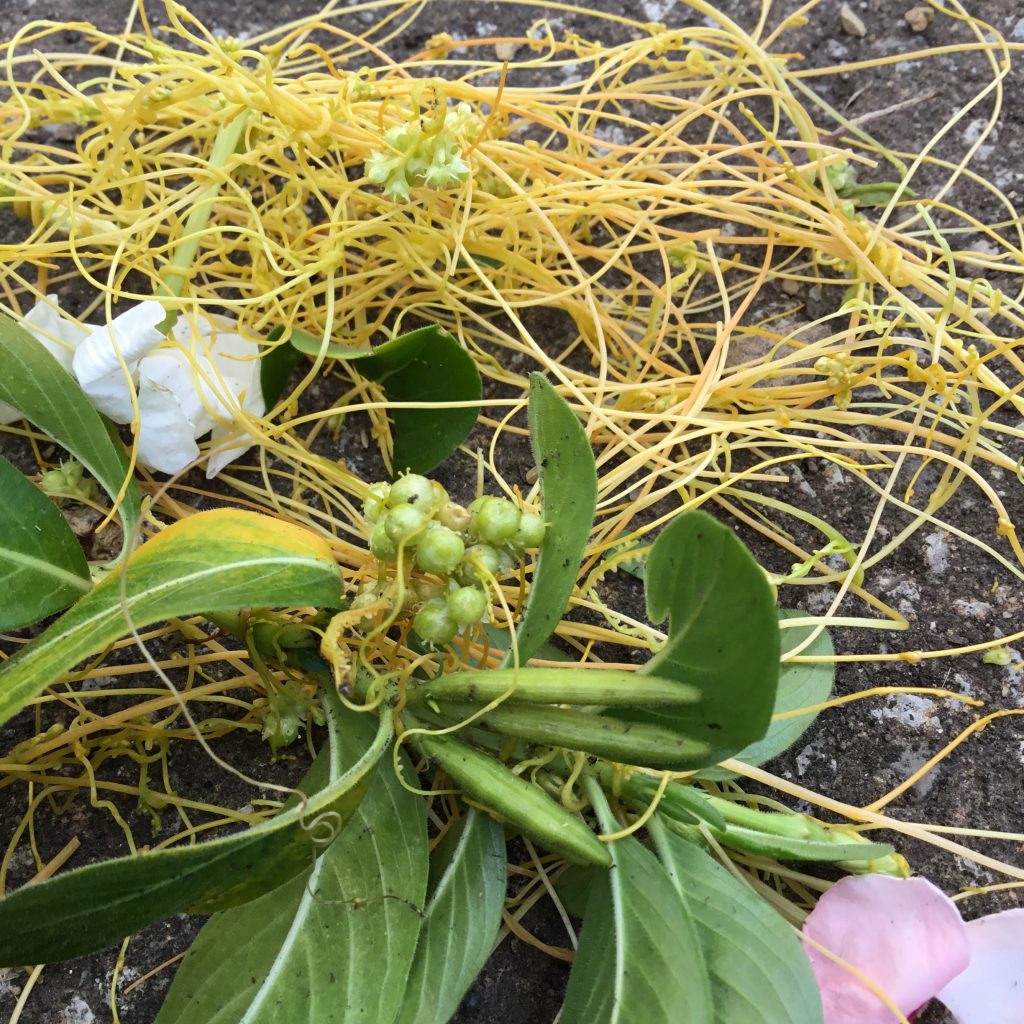Ask the Gardener: Dodder, schefflera cuttings, basil and more
Posted on: October 14, 2019 | Written By: Doug Oster |
Everybody Gardens editor Doug Oster gets asked a lot of questions. A lot. And he doesn’t mind offering gardening advice. But rather than just limiting those answers to the person who asked, we thought it might be a good idea to share that wealth of knowledge with everybody.
There are three ways to send in your questions:
- Email askdoug@535mediallc.com
- Submit your question on our “Your Garden” section of our site
- Send us a message on Facebook.
(The questions may be lightly edited for grammar/clarity/etc.)

Question 1: Dodder
Veronica: Can you please explain what this is? This mess is on my vincas along our walkway.
Doug: That’s dodder, an awful weed that’s a parasite. It’s living off the vinca. Your biggest concern is the seeds that have formed, because you don’t want that plant to drop the seeds.
The host plant (vinca) and dodder need to be removed gently as not to let that plant release the seeds. You need to bag or burn both plants. Watch for any signs of new dodder seedlings and eliminate them immediately. Hopefully you’ll get everything. Next year don’t plant vinca there, as that’s one of the host plants for dodder.
Here’s some more information with two organic strategies, but one chemical, which I would not recommend. There’s more detailed information about the plant though from this link.
Question 2: Schefflera cuttings
C.A.: I have two schefflera plants. One is very large with leaves about as big as your hand and over 10 feet tall. The other is bushier with smaller leaves and stems. I need to cut both back to bring in for the winter. Is there a way to root the cuttings? The large plant’s stem is about 3 inches around, and the smaller ones are a little bigger than a finger. I hate to just toss them.
Doug: Schefflera are pretty easy to root. Everyone does it a little differently, but here’s how I do it.
Take cuttings from the smaller shoots around the outer edges of the plant. Dip the ends in a rooting hormone and put them in a moist, but not soaking growing medium. A commercial planting mix that’s a little on the dry side works well although I personally prefer to use vermiculite. The downside to the vermiculite is that you have to transplant into a growing medium after the plants root. The plus side is the cuttings are less likely to rot.
Whichever medium you use, cover the cuttings with clear plastic and put them in indirect light, not full sun. After a couple of weeks, remove the plastic and gently pull on the cutting. If it resists, then the plant has rooted. If not, put the plastic back on and give the plant more time.
Question 3: Basil and orchids
Sherri: Can store-bought basil plants be replanted after they’re done growing? Orchids too? The basil is in pots, bought from stores here, but the leaves stopped producing a while ago. Same with the orchid, the flowers just faded one day, about a month ago. I have heard yes, but not conclusively.
Doug: For the basil, it will keep producing if it’s happy. It probably needs a little fertilizer. Be sure you are not overwatering it. I like this organic Grow from Espoma.
The orchid is a different story. Bring it inside just before the weather gets cold enough to kill it. Grow it on the windowsill and be sure to keep it on the dry side. In late February, you can start some light fertilization and eventually take it back outside at the end of May.
Question 4: Critter problems
Pat: Our yard is being dug up by an underground animal. The sod is pulled back in a hunk to expose the ground underneath. There is a hole nearby about 2 inches in diameter. Do you know what these are and how to get rid of them?
Doug: My guess would actually be skunk or opossum looking for grubs. They will rip up sod to feed on them. Once it gets cold, you won’t have to worry as the grubs go deep. The key to eliminating the problem is getting rid of the grubs safely. I use something called beneficial nematodes. They are a living organism that will hunt down the grubs. You can find it at good nurseries.
Previous mailbags
Saving lilies, plant ID, volunteer squash and more
Azalea issues, crabgrass and perennial problems
Green tomatoes, arborvitae and millet
Pokeweed, weed control, osage orange and more
Gardenias, arbor vine, hydrangeas and more
Transplanting rose of Sharon, sedums and more
Amaryllis flowering early, ornamental grass and more
Growing garlic, liriope problems and calla lilies
Plant ID, knotweed, tree selection and more
Magnolia tree, cactus care, avocados and more
More from Everybody Gardens
See also, Saving Dahlias: How To Remove And Store Dahlia Tubers